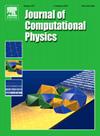Regularized lattice Boltzmann method based maximum principle and energy stability preserving finite-difference scheme for the Allen-Cahn equation
IF 3.8
2区 物理与天体物理
Q2 COMPUTER SCIENCE, INTERDISCIPLINARY APPLICATIONS
引用次数: 0
Abstract
The Allen-Cahn equation (ACE) inherently possesses two crucial properties: the maximum principle and the energy dissipation law. How to preserve these two properties at the discrete level is of significant importance in the numerical methods for the ACE. In this paper, unlike the traditional macroscopic numerical schemes that directly discretize the ACE, we first propose a novel mesoscopic regularized lattice Boltzmann method based macroscopic numerical scheme for the d (=1, 2, 3)-dimensional ACE, where the DdQ [() discrete velocities in d-dimensional space] lattice structure is employed. In particular, the proposed numerical scheme has a second-order accuracy in space, and can also be regarded as an implicit-explicit finite-difference scheme for the ACE. In this scheme, the nonlinear term is discretized semi-implicitly, the temporal derivative term and the dissipation term are discretized via the explicit Euler and second-order central difference methods, respectively. Compared to the implicit schemes for the ACE, the present scheme proves to be more efficient as it is actually explicit and avoids the use of iterative methods when dealing with the nonlinear term. In addition, we also demonstrate that under some certain conditions, the proposed scheme can preserve the maximum bound principle and the original energy dissipation law at the discrete level. Finally, we conduct numerical simulations of several benchmark problems, and find that the numerical results are not only in agreement with our theoretical analysis, but also show that in comparison with the mesoscopic lattice Boltzmann method, the proposed macroscopic scheme has a great advantage in reducing the memory usage.
求助全文
约1分钟内获得全文
求助全文
来源期刊

Journal of Computational Physics
物理-计算机:跨学科应用
CiteScore
7.60
自引率
14.60%
发文量
763
审稿时长
5.8 months
期刊介绍:
Journal of Computational Physics thoroughly treats the computational aspects of physical problems, presenting techniques for the numerical solution of mathematical equations arising in all areas of physics. The journal seeks to emphasize methods that cross disciplinary boundaries.
The Journal of Computational Physics also publishes short notes of 4 pages or less (including figures, tables, and references but excluding title pages). Letters to the Editor commenting on articles already published in this Journal will also be considered. Neither notes nor letters should have an abstract.
 求助内容:
求助内容: 应助结果提醒方式:
应助结果提醒方式:


